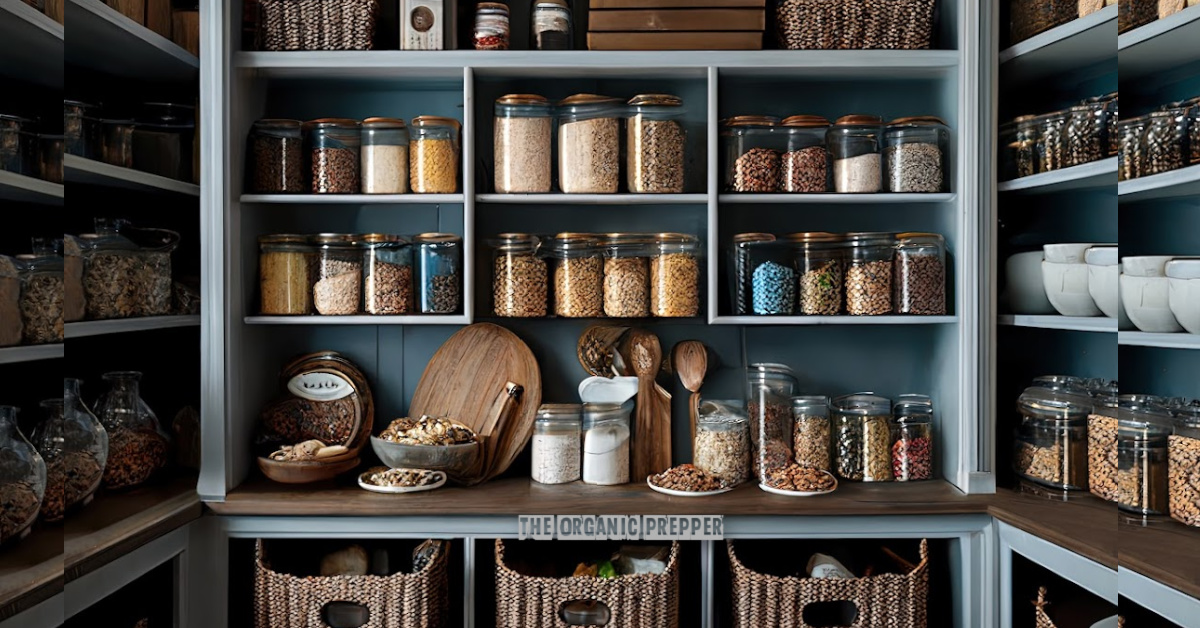(Psst: The FTC wants me to remind you that this website contains affiliate links. That means if you make a purchase from a link you click on, I might receive a small commission. This does not increase the price you’ll pay for that item nor does it decrease the awesomeness of the item. ~ Daisy)
Author of How to Prep When You’re Broke and Bloom Where You’re Planted online course
In every relationship, there comes a time when you have to sit down and take a serious look at the future. Where do you want to go? Are your goals compatible? Are things working as they stand right now, or do some changes need to be made? Creating the ultimate prepper food stockpile is no different.
People create prepper food stockpiles for many different reasons, and because of this, there is no “one-size-fits-all” formula for doing so. You must figure out what your goals are and develop a road map towards achieving them.
Having a food supply just makes sense. Every time there is a disaster, the masses become hysterical, and chaos ensues because there is no food available because of our “just-in-time” food delivery system. (Remember March of 2020?) Your stockpile can also mean the difference between continued freedom or forced compliance to get food.
There are three basic types of food supplies. Let’s look at these food storage ideologies. Then take the most applicable strategies and combine them to create your own version of the ultimate pantry.
The Bunker Pantry
This is the most “hardcore” of the prepper food stockpile types. A Bunker Pantry is the type of food supply that could keep you going for the next ten years without a single trip to the store. Sure, it might be a little bit boring and lacking in variety, but it is a supply that will see you through any disaster and allow you to remain in your shelter. This type of pantry focuses on huge quantities of long-term foods, repackaged carefully to resist spoilage due to pests or the elements.
If this is the type of pantry you’d like to build, focus on staples that last a long, long time, such as wheat, rice, dried beans, salt, and sugar. These foods can be purchased in bulk and repackaged by the user, or you can purchase them already packaged up through vendors like the LDS warehouse or online food storage websites.
Add emergency food buckets and freeze-dried foods to this for a bit (but not a lot) of variety. Here are some tips on food buckets.
The pros are that this kind of food supply can be created very quickly. If you have the money to do so, you can order all this stuff at once and shuffle it into your store room. As well, once you have it stored away, there’s a lot less rotating required. You can get it and forget it.
The cons are a very limited diet that may not be healthy for a long period of time, food fatigue from eating the same stuff for ages, and expense. This is by far the most expensive way to create a prepper food stockpile. As well, takes a lot of space to store this much food, so generally, a dedicated area must be used as a storeroom.
The Agrarian Pantry
This type of pantry is the kind our ancestors had. Most of the food is acquired during the growing season, and only small shopping trips are needed to supplement this throughout the year. It combines enough basic staples for the year ahead with enough of your preserved harvest to get you through the next growing season.
This type of pantry must be replenished every year. Basically, the items in your pantry are purchased and put back with the intention of consuming them within the next 12 months.
The pros to this prepper food stockpile are that it’s healthy, loaded with variety, and sustainable if you are growing or acquiring your food locally. I find it really enjoyable to preserve food and I like to be creative with the ways I put food back. (Get more ideas here.)
There are a few cons to this method as well. Not everyone has the space or ability to grow food. Farmer’s markets, where I used to get tons of fresh food to preserve, have become expensive artisan havens. A bad harvest can mean a lean year ahead if you are unable to supplement with store-bought goods. And finally, it’s a lot of work, and not every prepper is up for that.
The Bargain-Hunter’s Pantry
This is the type of pantry made famous by the extreme couponing shows. Using a variety of strategies, people can amass an enormous quantity of food for very little money. Couponing, sale shopping, bartering, and buying from outlet stores and warehouses can help to create a pantry full of packaged items.
The great thing about the bargain hunter’s pantry is that you can build up a huge amount of food on a very limited budget if you’re a smart shopper.
But there’s a downside to this method as well. While this is a great way to get started or to supplement your other strategies, this can make for an unhealthy diet. Much of what you are acquiring is highly processed, and without a lot of personal discipline, you aren’t building a balanced pantry but just stockpiling whatever is the cheapest. If you use this method, you must be extremely careful not to end up with a pantry filled with low-quality carbs and lacking in protein, fruits, and veggies. (Cheap ketchup is NOT a vegetable)
Combine the best of each strategy to build the ultimate prepper food stockpile.
The best prepper food stockpile combines the three strategies listed above to create the optimal supply for the needs of your particular family.
The key is organization. Keep the following tips in mind to create the best possible pantry.
- Keep an up-to-date inventory so that you know what you have
- Catalog your coupons by type and expiration date
- Track the sales cycles.
- Keep your products rotated into your kitchen so that you don’t lose foods to missed expiration dates.
- Store longer-term foods in optimum conditions to prolong their viability.
- Maintain a list of what is needed to balance your pantry nutritionally so that you can focus on those items when an unexpected bargain pops up.
- Buy pantry staples (like beans and grains) in the largest quantities you can manage in order to maximize your savings. (Learn more.)
- Remember the adage “Store what you eat and eat what you store.” It isn’t a bargain if you purchase something no one in your family will eat.
- Supplement your pantry by growing as much as possible in your particular circumstances, even if you are just adding a windowsill herb and salad garden. (Learn more here and here.)
- Tap into your inner hunter-gatherer with strategies like foraging, fishing, snaring, and hunting.
- Purchase seasonally and in large quantities from local growers (or harvest from your own gardens).
- Become a food preservation expert and stock up on the necessary tools and supplies. (Learn more.)
Use these strategies as a jumping-off point for your own ultimate prepper food stockpile. You may be able to improve your existing pantry by borrowing strategies from a different pantry type.
If you’re looking for more information on creating a pantry, I have a really popular course about building a pantry on a budget that you can take online. If you want hard copies of the information, check out my book, Prepper’s Pantry. I also compiled every food-related post from this website into a physical book called How to Feed Your Family No Matter What. It contains all our content on the storage, acquisition, preservation, and preparation of food.
Which is your favorite prepper food storage strategy?
Do you focus on one of these strategies over the others? Did you start out with one and then evolve to another? Do you combine all three? Do you have any advice for folks who are new to pantry building?
Let’s discuss pantries, food storage, and strategies in the comments section.
About Daisy
Daisy Luther is a coffee-swigging, adventure-seeking, globe-trotting blogger. She is the founder and publisher of three websites. 1) The Organic Prepper, which is about current events, preparedness, self-reliance, and the pursuit of liberty; 2) The Frugalite, a website with thrifty tips and solutions to help people get a handle on their personal finances without feeling deprived; and 3) PreppersDailyNews.com, an aggregate site where you can find links to all the most important news for those who wish to be prepared. Her work is widely republished across alternative media and she has appeared in many interviews.
Daisy is the best-selling author of 5 traditionally published books, 12 self-published books, and runs a small digital publishing company with PDF guides, printables, and courses at SelfRelianceand Survival.com You can find her on Facebook, Pinterest, Gab, MeWe, Parler, Instagram, and Twitter.
















